Purely Edible Hawaiian Potpourri
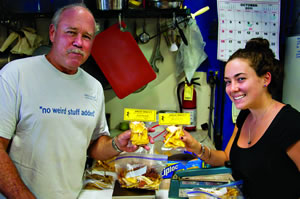
Mike Stewart with daughter Stephanie. Daniel Lane photos
Do you like dried fruit? I’ve never been a fan. Unless I was baking with it, I’d avoid the hard, strangely colored, gummy things.
Recently, however, I tried some dried fruit that tastes like the essence of Hawaii, and I have changed. I will eat dried fruit if it’s 100 percent Hawaiian fruit that Uncle Mikey made.
Every 1.6-ounce package bursts with fresh island flavors. Pineapple and starfruit are my favorites, but there also are mango, papaya, apple banana, guava and, when it’s in season, mountain apple. The flavors are intense, and it’s nothing but fruit.
“No weird stuff added,” says Mike Stewart, owner of Uncle Mikey’s. “I don’t add anything. It’s just straight dried fruit like our ancestors used to do.”
I like that Stewart has taken the time to refine his technique, so he can bring out the best in Mother Nature without using one chemical.
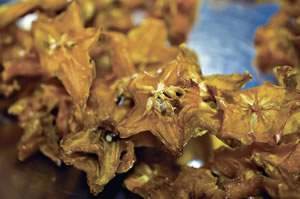
Dried starfruit with crunchy edible seeds
“Anybody can cut a fruit and put it in a dehydrator,” says Stewart, who hand cuts every piece. “But knowing when it’s ready, and when it’s going to be good in two, three, four months? That’s art.”
In 2003, Stewart was frustrated. Selling timeshare condos wasn’t fulfilling, and he had a persistent dream. He never was a dried fruit fan, but in 1991 he met a lady at a farmers market in California. She gave him a taste of the best dried fruit he’d ever had, and a seed was planted.
“Most adults sit on these great ideas and never make a move,” Stewart says. “I decided I wanted to do something so I could have a family business that could span generations.”
Stewart began drying fruit at home and was happy with the results. He worked out a deal with friend Matt Ernsdorff, owner of the Lighthouse Bistro in Kilauea, so he could dry his fruit in a commercial kitchen. He bought a commercial dehydrator, and they had to take a wall off the restaurant to get the behemoth inside. But that was the easy part.
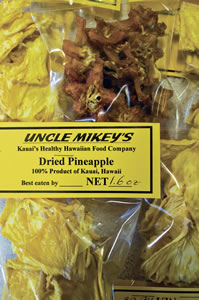
Portable Hawaiian sunshine
“When I got my dehydrator, I got this big book called Dehydration 101,” he recalls, “but it just showed me how to turn it on. It didn’t tell me about the science of drying fruit.”
After 30 years of marketing in the nutritional field, Stewart knew the benefits of raw food. “I knew there was a cutoff point where you couldn’t take the temperature over, otherwise you’re killin’ it,” he says. “You’re cooking the enzymes out, you know, destroying the life force, or the mana.”
With his technique perfected and his commercial kitchen secured, Stewart turned his focus to buying massive amounts of local fruit. In the ’70s, he worked in a taro patch in Wainiha Valley. For 10 years, he cultivated a deep respect for farmers, and believes they are a dying breed. Now, instead of farming, he goes through 1,000 pounds of fruit a week.
“I get my fruit from local farmers, and for the most part, if you get fruit from North Shore Kaua’i farmers, it’s organic,” he says, noting that even though Uncle Mikey’s is not certified organic they use the same techniques and have a passion for preserving the ‘aina.
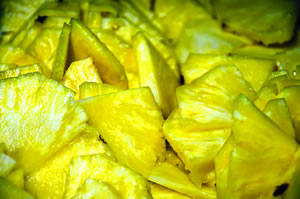
Pineapple ready for the dehydrator
“There’s no farm on Kaua’i that can solely produce for me, especially pineapple,” he says regretfully. “I get most of my off-island stuff from Esaki’s Produce, and Earl at Esaki’s is just awesome. He’s championed for me, and taught me a lot about fruit.”
Persistence has paid off, and Uncle Mikey knows his fruit. It’s hard for me to decide which I like better. The pineapple is pale yellow, like early morning sun. It’s sliced thin and it’s flexible. A pure pineapple flavor explodes in my mouth.
Then there’s the starfruit. Again, thinly sliced, chewy and concentrated starfruit flavor. But what I really like is that he leaves the seeds in, and they add a delicate crunch that is unique and fun.
Beautiful strips of mango are piney, sweet and tart. Bananas have been sliced lengthwise, and, I hate to be redundant, but they taste just like apple bananas.
The only thing I’m not surprised about is Uncle Mikey’s popularity.
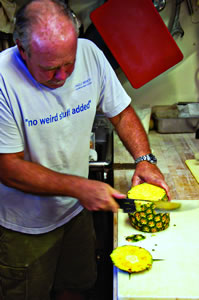
Stewart hand-cuts pineapple
Vosges Haut Chocolat, out of Chicago, is making a chocolate banana peanut butter bar using Stewart’s dried bananas. Uncle Mikey’s fruit is sold in 12 countries, on every island including Whole Foods on Oahu, and can be found in 25 stores islandwide.
“Papaya’s has the best price at $2.69 a bag; average price is $3.50 to $4 a bag,” says Stewart. “It’s a great carbohydrate. It’s just straight fruit sugar, so it’s a quick hit of energy. It’s also a great gift and snack for skiing. There’s nothing like opening a bag of pineapple at 5 degrees below zero.”
Here is a partial list of stores that sell Uncle Mikey’s:
Aloha Juice Bar Kilauea Town Market Banana Joe’s Harvest Market Papaya’s Natural Foods and Cafe
Living Foods Kukuiula Market SOS Farms Uncle Mikey’s Mike Stewart 645-1928 unclemikeys.net
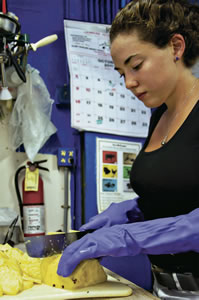
Stephanie lends a hand
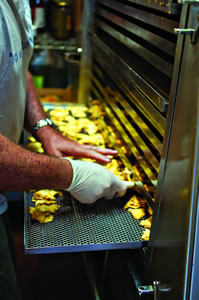
Pineapple in the dehydrator. Daniel Lane photos



